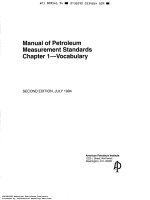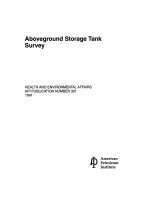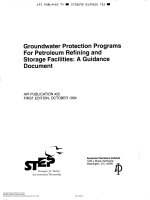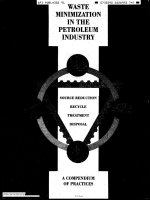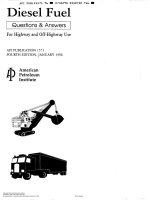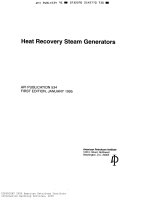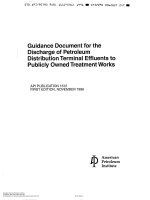Api publ 4592 1994 scan (american petroleum institute)
Bạn đang xem bản rút gọn của tài liệu. Xem và tải ngay bản đầy đủ của tài liệu tại đây (2.09 MB, 76 trang )
A P I PUBL*4592 94 I0732270 0517413 084
Odor Threshold Studies
Performed with Gasoline and
Gasoline Combined with MTBE,
ETBE and TAME
HEALTH AND ENVIRONMENTAL SCIENCES
API PUBLICATION NUMBER 4592
JANUARY 1994
American Petroleum Institute
1220 L Street. Northwest
Washington, D.C. 20005
11’
--`,,-`-`,,`,,`,`,,`---
Copyright American Petroleum Institute
Provided by IHS under license with API
No reproduction or networking permitted without license from IHS
Not for Resale
API P U B L r 4 5 9 2 94
0732290 0517414 T I O
Odor Thresholds Studies Performed with
Gasoline and Gasoline Combined with
MTBE, ETBE and TAME
Health and Environmental Sciences Department
API PUBLICATION NUMBER 4592
PREPARED UNDER CONTRACT BY:
TRC ENVIRONMENTAL CORPORATION
5 WATERSIDE CROSSING
WINDSOR, CONNECTICUT
DECEMBER 1993
--`,,-`-`,,`,,`,`,,`---
American
Petroleum
Institute
Copyright American Petroleum Institute
Provided by IHS under license with API
No reproduction or networking permitted without license from IHS
Not for Resale
API PUBL*4592 94 m 0 7 3 2 2 9 0 05117435 957 m
FOREWORD
API PUBLICATIONS NECESSARILY ADDRESS PROBLEMS OF A GENERAL
NATURE. WITH RESPECT TO PARTICULAR CIRCUMSTANCES, LOCAL, STATE,
AND FEDERAL LAWS AND REGULATIONS SHOULD BE REVIEWED.
AFI' IS NOT UNDERTAKING TO MEET THE DUTIES OFEMF'LOYERS, MANWACTLJRERS, OR SUPPLIERS To WARN AND PROPERLY TRAIN AND EQUIP THEIR
EMPLOYEES, AND OTHERS EXPOSED, CONCERNING HEALTH AND SAFETY
RISKS AND PRECAUTIONS, NOR UNDERTAKING THEIR OBLIGATIONS W E R
LOCAL, STATE, OR FEDERAL LAWS.
NOTHING CONTAINED IN ANY API PUBLICATION IS TO BE CONSTRUED AS
GRANTING ANY RIGHT, BY IMPLICATION OR OTHERWISE, FOR THE MANUFACTURE, SALE, OR USE OF ANY METHOD, APPARAWS, OR PRODUCT COVERED BY LETTERS PATENT. NEITHER SHOULD ANYTHING CONTAINED IN
THE PUBLICATION BE CONSTRUED AS INSURING ANYONE AGAINST LIABILITY FOR INFRINGEMENT OF LETTERS PATENT.
Copyright Q 1994 American Petroleum Institute
--`,,-`-`,,`,,`,`,,`---
Copyright American Petroleum Institute
Provided by IHS under license with API
No reproduction or networking permitted without license from IHS
ii
Not for Resale
A P I PUBL+4592 74
= 0732290 05l174Lb 8 9 3 =
--`,,-`-`,,`,,`,`,,`---
ACKNOWLEDGMENTS
THE FOLLOWING PEOPLE ARE RECOGNIZED FOR THEIR CONTRIBUTIONS OF
TIME AND EXPERTISE DURING THIS STUDY AND IN THE PREPARATION OF
THIS REPORT
MI STAFF CONTACT
Robert Barter Ph.D., Health and Environmental Sciences Department
AD HOC WORKGROW OF THE TOXICOLOGY TASK FORCE
Charles R. Clark B . D . , Unocai Corporation
Wayne Daughtrey Ph.D., Exxon Biomedicai Sciences
Mark D. Saperstein ARCO
iii
Copyright American Petroleum Institute
Provided by IHS under license with API
No reproduction or networking permitted without license from IHS
Not for Resale
A P I PUBLJ4592 ỵ 4
= 0732290
05L7417 7 2 T
TABLE OF CONTENTS
SECTION
PAGE
EXECUTIVE SUMMARY
e5-1
1.
INTRODUCTION
1-1
2.
EXPERIMENTAL PROCEDURES
2-1
TASTE EVALUATION PROCEDURES
2-1
ODOR EVALUATION PROCEDURES
Threshold Determinations in Air Samples
Threshold Determinations in Aqueous Samples
2-2
CALCULATION OF ODOR AND TASTE THRESHOLD VALUES
2-8
PANEL
3.
2-2
2-8
.
RESULTS AND CONCLUSIONS
2-12
3-1
TASTE EVALUATION RESULTS
3-1
ODOR EVALUATION RESULTS
Results From the Evaluation of MTBE
Results From the Evaluation of Gasoline
Results From the Evaluation of the Gasoline and
Oxygenate Mixtures
3-1
3-1
3-3
CONCLUSIONS
3-9
REFERENCES
R- 1
APPENDIX A
MTBE Data Sheets
APPENDIX B
Gasoline Headspace Vapor Data Sheets
APPENDIX C
Gasoline-Oxygenate Headspace Vapor Data Sheets
--`,,-`-`,,`,,`,`,,`---
Copyright American Petroleum Institute
Provided by IHS under license with API
No reproduction or networking permitted without license from IHS
3-5
Not for Resale
A P I P U B L * 4 5 9 2 94
m 0732290 0537438
bbb
m
LIST OF TABLES
TABLE
2-1
TFIC SOLVENT BAG STANDARD PREPARATION DATA FORM
2-3
2-2
E[), EVALUATION FORM FOR THE DYNAMIC
TFIIANGLE OLFACTOMETER
2-9
2-3
TABLE FOR CONVERSION OF RANK DATA TO X-AXIS
PL.OT VALUES
2-1o
3-1
TASTE THRESHOLD VALUES FOR MTBE IN WATER
3-1
3-2
ODOR DETECTION AND RECOGNITION THRESHOLD VALUES
FOR MTBE IN AIR AND WATER
3-1
3-3
ODOR INTENSITY VALUES FOR MTBE IN AIR AND WATER
3-2
3-4
OUOR DETECTION AND RECOGNITION THRESHOLD VALUES
FOR GASOLINE HEADSPACE VAPOR SAMPLES
3-3
--`,,-`-`,,`,,`,`,,`---
3-5
ODOR INTENSITY VALUES FOR GASOLINE HEADSPACE VAPOR
3-4
SAMPLES
3-6
ODOR DETECTION AND RECOGNITION THRESHOLD VALUES
GASOLINE-OXYGENATE HEADSPACE VAPOR SAMPLES
3-5
ODOR INTENSITY VALUES FOR GASOLINE-OXYGENATE
HEADSPACE VAPOR SAMPLES
3-7
3-7
LIST OF FIGURES
FIGURE
2-1
2-2
DW
C DIL ITION FORCED-CHOICE TRIANG E
OL-FACTOMETER
2r6
BLITANOL OLFACTOMETER
2-7
Copyright American Petroleum Institute
Provided by IHS under license with API
No reproduction or networking permitted without license from IHS
Not for Resale
A P I PUBL*4592 94
0 7 3 2 2 9 0 0517419 5 T 2
EXECUTIVE SUMMARY
The Clean Air Act Amendments of 1990 require that gasoline sold in areas of nonattainment for carbon monoxide or ozone contain specified amounts of fuel
--`,,-`-`,,`,,`,`,,`---
oxygenates. Fuel oxygenates include, methyl-tertiary-butylether (MTBE), ethyltertiary-butyl ether (ETBE), and tertiary-amyl-methyl ether (TAME). These oxygenated
compounds increase the oxygen content of fuels, producing a more complete
combustion, resulting in a reduction in carbon monoxide emissions. Oxygenated
compounds such as MTBE have been previously added to gasoline to enhance octane
ratings. More recently, larger amounts of oxygenates, MTBE, in particular, have been
added to fuels to meet Clean Air Act Amendment requirements. This study examines
the effect of oxygenate addition on the odor of gasoline blends.
Three blends of gasoline (summer, winter and a "composite") were evaluated for their
odor detection and recognition thresholds in air. These gasolines were also combined
with the gasoline oxygenates MTBE, ETBE or TAME to evaluate the effect of the
oxygenates on the gasolines' odor detection and recognition thresholds. Additionally,
commercial'grade MTBE (97% pure, obtained from ARCO Chemical Co.) was
evaluated for its odor detection and recognition thresholds in air and water as well as
its taste threshold in water. The detection threshold is defined as the minimum
concentration at which 50 percent of a given population can differentiate between a
sample containing the odorant and a sample of odor free air. The recognition
threshold value is defined as the minimum concentration at which 50 percent of a
given population can recognize or identify the odorant. These evaluations were
conducted at TRC Environmental Corporation's (TRC's) Odor Laboratory in Windsor,
Connecticut.
The average detection and recognition threshold values for commercial grade MTBE
were determined to be 0.053 and 0.1 25 parts-per-million (ppm), respectively. The
average detection and recognition threshold values for this MTBE in water were
ES-1
Copyright American Petroleum Institute
Provided by IHS under license with API
No reproduction or networking permitted without license from IHS
Not for Resale
A P I PUBL*4572
74 H 0732290 0537420 234 W
determined to be 0.045 and 0.055 ppm, respectively. In general, compounds with
odor thresholds below.1 ppm are considered highly odorous. The panelists
descriptions of MTBE's odor included alcohol, chemical, ether and butane. Finally, the
average taste detection threshold value for this oxygenate was determined to be 0.039
ppm. The panelists found the taste of MTBE to be highly objectionable.
The average detection and recognition threshold values for the headspace vapor of
the three gasoline blends are as follows: summer blend - 0.576 and 0.802 ppm,
respectively; winter blend - 0.479 and 1.121 ppm, respectively; and "composite"
blend - 0.474 and 0.765 ppm, respectively. In general, the panelists described all
three blends as smelling like gasoline.
the gasoline-oxygenate mixtures are as follows: summer blend + 3% MTBE (97%
purity) - 0.5 and 0.696 ppm, respectively; summer blend + 11% MTBE (97% purity) 0.275 and 0.710 ppm, respectively; summer blend + 15% MTBE (97% purity) - 0.264
and 0.686 ppm, respectively; summer blend + 15% MTBE (99% punty) - 0.1 13 and
0.358 ppm, respectively. The odors associated with these mixtures included organic
volatile, gasoline, ether, car exhaust, sweet gasoline and gasoline with ether. The
summer blend of gasoline was also mixed with 15% ETBE (99% purity) and also with
15% TAME (94% purity). The average detection and recognition threshold values for
these mixtures aire 0.064 and 0.139 ppm (summer blend + ETBE) and 0.1 14 and
0.207 ppm (summer blend + TAME). The odors the panelists associated with these
mixtures includeld ether, gasoline, chemical with gasoline, cleaning fluid and natural
gas.
The winter and composite gasolines were each mixed with 15% MTBE (97% purity),
respectively. The average detection and recognition threshold values for these
mixtures were 0.219 and 0.398 ppm (winter blend + MTBE) and 0.085 and 0.1 85 ppm
(composite blend + MTBE), respectively. The odor of the winter gasoline - MTBE
ES-2
Copyright American Petroleum Institute
Provided by IHS under license with API
No reproduction or networking permitted without license from IHS
Not for Resale
--`,,-`-`,,`,,`,`,,`---
The average detection and recognition threshold values for the headspace vapor of
A P I PUBL*4592 9 4
0732290 05L7421 150 M
mixture was associated with gasoline, chemical and ether by the panelists. The odor
of the "composite" gasoline - MTBE mixture was associated with gasoline, gasoline
--`,,-`-`,,`,,`,`,,`---
with ether, and permanent marker by the panelists.
ES-3
Copyright American Petroleum Institute
Provided by IHS under license with API
No reproduction or networking permitted without license from IHS
Not for Resale
A P I PUBLX4572 74
m
0 7 3 2 2 7 0 0 5 1 7 4 2 2 O97
m
Section 1
INTRODUCTION
The Clean Air Act Amendments of 1990 require that gasoline sold in areas of nonattainment for carbon monoxide or ozone contain specified amounts of fuel
oxygenates. Fuel oxygenates include, methyl-tertiary-butyl ether (MTBE), ethyltertiary-butyl ether (ETBE), and tertiary-amyl-methyl ether (TAME). These oxygenated
--`,,-`-`,,`,,`,`,,`---
compounds increase the oxygen content of fuels, producing a more complete
combustion, resulting in a reduction in carbon monoxide emissions. Oxygenated
compounds such as MTBE have been previously added to gasoline to enhance octane
ratings. More recently, larger amounts of oxygenates, MTBE, in particular, have been
added to fuels to meet Clean Air Act Amendment requirements. This study examines
the effect of oxygenate addition on the odor of gasoline blends. A commercial blend
of MTBE (97% purity, obtained from ARCO Chemical Co.) was also evaluated for its
odor detection and recognition thresholds in air and water as well as its taste
threshold in water. MTBE (99% purity) and ETBE (99% purity) were also supplied by
ARCO Chemical Company. TAME (94% purity) was obtained by API from Aldrich
Chemical Company and supplied to TRC through APl's chemical repository,
Experimental Pathology Laboratories, Inc. (Herndon, VA). The gasoline blends were
furnished through Experimental Pathology Laboratories, Inc., Herndon, VA (summer
blend - API Reference Fuel 91-01), and Sun Co., Inc., Marcus Hook, PA (winter blend
and "composite" sample). The Reid Vapor Pressure (RVP) for the gasoline blends (in
psi) are 8.5, for the summer blend; 12.3 for the winter blend; and 7.9 for the
"composite sample".
1-1
Copyright American Petroleum Institute
Provided by IHS under license with API
No reproduction or networking permitted without license from IHS
Not for Resale
A P I PUBL*4592 94
œ O732290 0537423
T23
œ
Section 2
EXPERIMENTAL PROCEDURES
TASTE EVALUATION PROCEDURES
The taste threshold determinations met the criteria specified in Review of Publis,,ec
Odor and Taste Threshold Values of Soluble Gasoline Components (TRC, 1985).
These criteria are summarized as follows:
--`,,-`-`,,`,,`,`,,`---
1. Panel selection of at least six per group;
2. Panel selection based on taste sensitivity;
3. Panel calibration;
4. A "sip" and "spit" presentation method;
5. Room temperature solutions;
6. Purified water as a diluent;
7. Rinse between stimuli;
8. Consideration of threshold type;
9. Staircase presentation series;
1O. Forced-choice procedure;
11. Repeated trials;
12. Concentration step increasing by a factor of two or three.
TRC performed the taste threshold testing following the procedure in Standard Method
2160B for the Examination of Water and Wastewater (APHA et al., 1992). The taste
threshold value of MTBE was determined by comparing this oxygenate with water.
Aliquots of the MTBE solutions used for the aqueous odor testing were also used for
the taste tests. The samples were presented to the panelists in a series of increasing
concentrations, and each sample was paired with a water reference. Each panelist
was required to sip the sample via straw, hold it inside the mouth for a few seconds
and discharge it without swallowing. The panelist then compared the sample of
oxygenate with the reference sample and indicated whether or not a flavor or
aftertaste could be detected.
2- 1
Copyright American Petroleum Institute
Provided by IHS under license with API
No reproduction or networking permitted without license from IHS
Not for Resale
A P I PUBL*4592 9 4
0732290 0517424 9bT
ODOR EVALUATION PROCEDURES
These studies were conducted in TRC's Odor Laboratory in Windsor, Connecticut.
The odor threshold determinations met the criteria specified in Review of Published
Odor and Taste Threshold Values of Soluble Gasoline Components (TRC, 1985).
These criteria are summarized as follows:
Threshold Determinations in Air Samples
Air samples of neat MTBE were produced by vaporizing a known volume of MTBE
(0.6 pl) in a known volume of hydrocarbon-free air (0.400 fi3) which was contained in a
TedlarB bag. The concentration in each sample bag was calculated according to the
equation presented in Table 2-1 and expressed in parts-per-million (ppm). The
average starting concentration of MTBE in the Tedlaa bag was calculated to be 11.16
PPm.
In contrast to the wholly vaporized MTBE samples, the headspace vapor samples
from the summer, winter and "composite" gasolines as well as from the gasolineoxygenate mixtures were generated by a mini-impinger system. Ten milliliters of
gasoline or gasoline-oxygenate mixture were placed into a glass impinger. Carbonfiltered air was passed through an inlet tube over the headspace and the vapor was
collected through an outlet tube into a Tedla? bag. The resultant headspace vapor
was diluted approximately 2000-fold prior to presentation to the odor panel. The
2-2
Copyright American Petroleum Institute
Provided by IHS under license with API
No reproduction or networking permitted without license from IHS
Not for Resale
--`,,-`-`,,`,,`,`,,`---
1. Panel selection of at least six per group;
2. Panel selection based on odor sensitivity;
3. Panel calibration;
4. Consideration of vapor modality (air and water);
5. Diluent in accord with compound;
6. Presentation mode that reduces ambient air intake;
7. Analytical measurement of odorant concentration;
8. Calibration of flow rate and face velocity (for olfactometers);
9. Consideration of threshold type (detection or recognition);
1O. Ascending presentation series;
11. Repeated trials;
12. Forced-choice procedure;
13. Concentration step increasing by factor of two or three.
A P I PUBL*4592 94
= 0732290 0 5 1 7 Y 2 5
8Tb
Table 2-1. TRC Solvent Bag Standard Preparation Data Form
TRC Projecc
Dace
Loca t i o n
Technician-
Solvenc S p e c i e s
Holecular Ueighc
Dens i c y
Di lut ion
Gas
Ambient
Temper a cur e
Pressure
Barornectic
Dry Gar Heter C a l i b r a t i o n Factor ( Y )
Volune o f
In jeered
Soivenc
(uL)
.Bag No.
NOE:
Pa
-
Tm
fm
- (OF)
(OK)
p r c i s u r e measured
AC
Volume of
Pm
DiLuCion Gar
( i n . Hg)
(fc')
PDCX
(in. YaO)
t h e dry gas mecer (PCCH) + barometric precaurc.
Standard c o n d i t i o n s a r e 68'F,
29.92 inches Hg.
2-3
--`,,-`-`,,`,,`,`,,`---
Copyright American Petroleum Institute
Provided by IHS under license with API
No reproduction or networking permitted without license from IHS
Solveoc
Concencracion
( ppm)
Not for Resale
A P I PUBL*4592 9 4
m 0732290
0 5 3 7 4 2 6 732
m
concentration (in ppm) of total hydrocarbons in the Tedla? bags containing the diluted
gasoline headspace vapor was approximated by using an Organic Vapor Analyzer
(OVA) (Foxboro 128). The OVA was calibrated against a gaseous mixture of 45%
butane, 45% pentane and 10% hexane. The Tedlap bag containing the diluted
reading obtained.
The readings for each sample were recorded on the appropriate ED,
evaluation forms
(Appendices B and C). An API study of consumer gasoline vapor exposure during
refueling demonstrated that approximately 80% of gasoline vapors are comprised of
saturated C,-C,
compounds (Clayton Environmental Consultants, 1993).
The dilution-to-threshold (DR) values used to calculate the threshold concentration
levels were measured with a dynamic dilution triangle olfactometer (IITRI System,
1979 Model). The D/T value represents the ratio of the volume of odor-free air that
must be added to the odorous sample to reach threshold. For example, a D/T of 100
means that 100 volumes of odor-free air must be added to one volume of odorous air
to dilute it to threshold. The D/T ratio represents that dilution required for 50% of the
panel to detect a difference between the odorous stimuli and the blank air.
On the triangle olfactometer, this is the point at which the panelist successively
identifies the sniff port containing the odor. The olfactometer uses carbon-filtered air
to make six simultaneous dilutions of the odorous air. A series of dilutions were
presented in an ascending manner, each series representing approximately a threefold concentration step. The dilution ratios, as determined by a soap film flow-meter,
were approximately: U241 1, 1/608,1/175,1/55,1/24,1/8. Each dilution level was
presented by means of a cup containing three glass sniff ports. Two ports dispensed
only carbon filtered air while the third dispensed the diluted odor. Flow rates from the
sniffing ports were constant at 3 Uminute. Panelists chose which of the three ports
differed from the other two, ¡.e., the odor. The olfactometer and its procedures meet
2-4
Copyright American Petroleum Institute
Provided by IHS under license with API
No reproduction or networking permitted without license from IHS
Not for Resale
--`,,-`-`,,`,,`,`,,`---
gasoline headspace vapor was then connected to the sampling port of the OVA and a
A P I PUBL+4592 94
0732290 0537427 b 7 9
the requirements of ASTM Standard Practice E 679 (ASTM, 1993a). A schematic
illustration of the olfactometer is depicted in Figure 2-1. The D/T value was calculated
by log dilution level versus probability plots. The probability of correct response at 50
percent was plotted against odorant concentration for 'a best fit (least squares) straight
line function. This D/T determination method is recommended for use with the IITRI
Olfactometer System, and is also recommended by ASTM Standard Practice E 679
(ASTM, 1993a).
Composite scores were used to determine two types of thresholds, detection and
recognition. The detection threshold value differs from the recognition threshold value
in that, the detection threshold is the dilution at which a panelist is capable of
determining that there is a difference between the sample and filtered air. The
recognition threshold value is the dilution at which a panelist is capable of rating the
intensity of the odor on the butanol scale. Both the odor thresholds of detection and
recognition are expressed in parts-per-million. The thresholds were calculated by
dividing the concentration (ppm) in the sample bag by the D/T ratio (dimensionless) as
determined by odor panel evaluation. In addition, once panelists were able to rate the
intensity of the odor on the butanol scale, they were asked to describe the odor
associated with the sample.
The perceived odor intensity was measured with a dynamic dilution binary scale
olfactometer arranged in a "lazy Susan" configuration (Figure 2-2). Supra-threshold
levels of 1-butyl alcohol (Standard Reference ASTM E 544) were presented in two-fold
concentration steps (the butanol scale) (ASTM, 1993b). Panelists compared the ports
of the triangle olfactometer with the butanol and indicated the comparable level. The
panelists were asked to rate the intensity of the odor on all subsequent dilutions after
the odor was detected. The intensity of the odor was rated on a scale of 1 to 8 (as
compared to port number 1 through 8). Ratings of 1 through 3 are considered weak
odors, ratings of 4, 5 and 6 are considered moderate odors and ratings of 7 and 8 are
strong odors.
2-5
--`,,-`-`,,`,,`,`,,`---
Copyright American Petroleum Institute
Provided by IHS under license with API
No reproduction or networking permitted without license from IHS
Not for Resale
API PUBL*4592 94
Greatest
Dilution
0732290 0537428 505
Lowesf.
Dilut ron
)
-
S n i f t e r Port
Select ion
Button
Flow
Meter
-
Selection Light Box
--`,,-`-`,,`,,`,`,,`---
I
Figure 2-1. Dynamic Dilution Forced-Choice Triangle Olfactometer
2-6
Copyright American Petroleum Institute
Provided by IHS under license with API
No reproduction or networking permitted without license from IHS
Not for Resale
API P U B L X 4 5 7 2 94
0732290 053’7429 4 4 1
=
--`,,-`-`,,`,,`,`,,`---
Odor Splitter
I
In-ìine
7 Flowmeters
Odorant Vapor
Generator
/
HANDLE
STOP
Figure 2-2. Butanol Olfactometer
2-7
Copyright American Petroleum Institute
Provided by IHS under license with API
No reproduction or networking permitted without license from IHS
Not for Resale
A P I PUBLm4592 94
= O732290
0517430 L b 3
Threshold Determinations in Aqueous Samples
TRC determined the odor thresholds of MTBE in its aqueous phase, following the
Standard Method 2150 for the Examination of Water and Wastewater (APHA et al.,
1992). A known concentration of MTBE was diluted with distilled water in a fixed ratio
and evaluated organoleptically. Following Method 2150, aqueous samples (contained
in flasks) with known concentrations of MTBE were presented to each panelist in
ascending order from the weakest to the highest concentration. Based on the results
of preliminary tests, a set of dilutions of MTBE was prepared. The nominal
concentrations of the samples used in the aqueous odor testing were calculated to be
0.023 ppm, 0.046 ppm, 0.093 ppm, 0.185 ppm, 0.370 and 0.740 ppm MTBE. Each
sample was presented to the panelist accompanied by two flasks that contained
distilled water. The panelist sniffed the headspace of each flask and indicated
which flask was different from the other two. The odor threshold is the dilution ratio at
which the odor was just detected.
CALCULATION OF ODOR AND TASTE THRESHOLD VALUES
The odor and taste threshold values were calculated using a statistical-linear
regression method. Tables 2-2 and 2-3 are used to calculate the threshold values.
Table 2-2 is the ED,
Evaluation Form for the Dynamic Triangle Olfactometer. The Y-
values of the linear regression are derived from the calibration data of the
olfactometer. These Y-values are the log of the tolerance level concentration which is
calculated by averaging adjacent dilution levels. Once each panelist has evaluated
the sample, a frequency tally is taken which indicates the number of times the sample
is first detected per concentration. An average rank for all panelists is then
determined using the rank count number scale. The X-plotting value is determined
using a conversion table (Table 2-3). The pairs of X and Y values are then used to
2-8
--`,,-`-`,,`,,`,`,,`---
Copyright American Petroleum Institute
Provided by IHS under license with API
No reproduction or networking permitted without license from IHS
Not for Resale
A P I PUBLX4592 94
0732290 0517431 O T T
Table 2-2. ED,, Evaluation Form for the Dynamic Triangle Olfactometer
,t:
P
-
L
Log(To1erancc
Level)
Log (Dllution
Factor)
dilution
k v c l No.
.
f
t
2-9
--`,,-`-`,,`,,`,`,,`---
Copyright American Petroleum Institute
Provided by IHS under license with API
No reproduction or networking permitted without license from IHS
Not for Resale
Average Rank
.l .o
1.5
2.0
2.5
3 .O
--`,,-`-`,,`,,`,`,,`---
3.5
4.0
4 .s
5.0
5.5
6.0
6
~1.O7
~0.79
-0.57
-0.37
-0.18
O
tO.38
+0.37
+D. 57
+O .7 9
+1 .O7
6.5
7 .o
7 .ä
- --
Number o f Pai If t t s
7
0
9
-1 015
-0.89
-0.67
-0.99
-0.32
-O .l6
O
+O.l6
+0.32
+0.49
+O. 67
+0.89
41.15
8.0
8.5
9 .o
9.5
10.0
-
-0 97
-0.77
-0.59
-0.43
WO.28
-0 S 4
O
+0.14
+O. 28
+0.43
i0.59
+O .77
+O. 97
+l022
-1.21
4 .o4
-Om84
-0.67
-0.52
4.39
-0.25
-0.13
o.
-1 033
-1.10
-0.91
-0.75
-0m60
-0 47
-0.35
-0.23
-0011
.
+0.13
+0.25
+o 011
+0.39
+0,23
+0.52
+O 67
+D. 84
+1 .o4
+1.28
+0.35
+0.47
+.O 60
.
0
.
+0m75
+o. 93
+1.IO
+le 3 3
-
2-1o
Copyright American Petroleum Institute
Provided by IHS under license with API
No reproduction or networking permitted without license from IHS
-1.22
10
Not for Resale
A P I PUBLx4592 9 4
m 0732290 0537433
972
m
calculate the dilution-to-threshold (D/T) by a least squares method. The equation that
is used is:
-
Log D/T = Y -{
[{(XY) - N
v x}/{(X2) - N (
%)2}]}
(Equation 2-1)
-
Y = mean value of all log (tolerance level) values actually used.
X = mean value of plotting values.
(XY) = sum of products of each X with corresponding Y.
(x') = sum of squares of x values.
N = number of plotting values.
This equation automatically calculates the best-fit straight line for the data and
provides the log of the D/T. For example, Appendix A provides the olfactometer ED,
evaluation forms for the vaporized MTBE samples, in which the D/T values were
calculated as just described. As seen in the first sheet (Sample A) the Y values (log
tolerance level) to plot the detection threshold are 3.681,3.083,2.514,1.992 and
0.732. A frequency tally of the initial odorant detection is made (circled samples on
ED50sheet). The frequency tallies (with respective average rank values in
parentheses) are 1 (l), 1 (2),3 (4),1 (6)and 1 (7). The average rank values were
then converted to the X values of -1.1 5,-0.67,
O, 0.67 and 1.1 5 respectively.
Therefore the X,Y plotting values are -1.15,3.681; -0.67,3.083;O, 2.514;0.67,1.992,
and 1.1 5,0.732. Using the least squares method, the D/T value is calculated to be
251. The concentration of MTBE in the bag (ppm) is divided by the D/T value to
obtain the odor threshold value in ppm (0.043ppm). The recognition threshold is
calculated the same way except that the frequency tally is of the initial odorant
recognition (first intensity ranking, designated on ED,
sheet by a number value in a
square). The odor and taste threshold values in water are also determined in a similar
manner.
2-11
Copyright American Petroleum Institute
Provided by IHS under license with API
No reproduction or networking permitted without license from IHS
Not for Resale
--`,,-`-`,,`,,`,`,,`---
where:
x
A P I PUBL*4592 9 4 W 0732290 0537434 8 0 9 W
PANEL
TRC Environmental Corporation maintains a pool of well-trained and experienced
panelists from the Hartford, Connecticut area for olfactory evaluation at TRC’s
Olfactory Laboratory located in Windsor, Connecticut. For these odor and taste
evaluation studies, the panel consisted of at least six individuals chosen to represent a
normal distribution of olfactory sensitivity such as found in the general population.
Prior to sample evaluation for odor thresholds, the panel was calibrated with a butanol
intensity series.
2-12
--`,,-`-`,,`,,`,`,,`---
Copyright American Petroleum Institute
Provided by IHS under license with API
No reproduction or networking permitted without license from IHS
Not for Resale
0732290 0537435 7 4 5
A P I PUBL*4592 9 4
=
Section 3
RESULTS AND CONCLUSIONS
TASTE EVALUATION RESULTS
MTBE (97%) was evaluated for its taste threshold in water (Table 3-1). The average
taste detection threshold value for this oxygenate, in these studies, was 0.039 ppm.
--`,,-`-`,,`,,`,`,,`---
The panelists found the taste of MTBE (even at the lowest concentrations) to be highly
objectionable.
Table 3-1. Taste Threshold Values for MTBE in Water (in ppm)
Oxygenate
Taste Threshold
Taste Characteristics'
0.039
0.039
"nasty",bitter, rubbing alcohol,
nauseating
97% MTBE
avg
0.039
' Combined odor characteristics from each sample within the group.
ODOR EVALUATION RESULTS
Results From the Evaluation of MTBE
The odor threshold values for MTBE in air and water are presented in Table 3-2. The
Table 3-2. Odor Threshold Values for MTBE in Air' and Water (in Dom)
Odor
Detection
Odor
Recognition
Odor
Characte?
0.043
0.058
0.058
0.105
0.159
0.110
chemical, ether, sour,
butane, alcohol, medicine,
cleaning fluid
0.053+0.005
O. 125+0.017
0.048
0.065
0.041
0.044
0.045
0.055
Oxygenate
97% MTBE (air)
avg
97% MTBE
(water)
avg
' Mean 2 Standard Error
'
alcohol
* Combined odor characteristics from each sample within the group.
3-1
Copyright American Petroleum Institute
Provided by IHS under license with API
No reproduction or networking permitted without license from IHS
Not for Resale
A P I PUBL*4592 9 4 M 0732290 051743b b 8 1 M
average detection and recognition threshold values for MTBE were 0.053 and 0.1 25
ppm, respectively. In addition, each panelist was asked to describe the odor
associated with the sample. These odor descriptions included chemical, alcohol, ether
and butane. The average odor detection and recognition threshold values for MTBE
in water were 0.045 ppm and 0.055 ppm, respectively. In general, compounds that
exhibit odor threshold values below 1 ppm, such as MTBE, are in general considered
highly odorous. The average odor intensity ratings for MTBE in air and water are
presented in Table 3-3. The average odor intensity rating for MTBE in air was 5.17
which indicates that this oxygenate has a moderate odor level at the concentration
tested, while the odor intensity for MTBE in water was 2.86.
Average
Conc.(pprn)'
Average
Odor Intensiv
Odor Intensity
at O Dilution3
Slope of
Odor Intensity
97% MTBE (air)
11.17
5.17
6.82
-0.42
97% MTBE
(water)
0.74
2.86
3.94
-0.82
--`,,-`-`,,`,,`,`,,`---
Oxygenate
The intensity values for each sample were extrapolated to a zero (O) dilution and the
slope values of the odor intensity vs. concentration line were also calculated. Since
odorant intensity increases as a function of concentration, these data indicate that the
odor of MTBE in water is more intense compared with MTBE in air. The slope of the
increase in the intensity of the odor of MTBE in water is also larger than the slope of
MTBE in air, indicating a faster increase in intensity as the concentration is increased.
The DTT evaluation forms for the dynamic triangle olfactometer, which include the
3-2
Copyright American Petroleum Institute
Provided by IHS under license with API
No reproduction or networking permitted without license from IHS
Not for Resale
A P I PUBL*V592 9 4 H 0732270 0537437 5 L B M
perceived odor characteristics of MTBE, as well as the aqueous MTBE odor and taste
data sheets, are provided in Appendix A and present the responses of each panelist.
The detection and recognition threshold values for each sample are calculated using
this data as described in Section 2.
Results From the Evaluation of Gasoline
The threshold values and odor intensity ratings for the individual headspace samples
of the three gasolines are presented in Tables 3-4 and 3-5, respectively. The average
detection and recognition threshold values for the summer blend of gasoline were
0.576 and 0.802 ppm, respectively. The odor of the summer gasoline was associated
intensity rating of 2.26 for the summer
Table 3-4. Odor Detection and Recognition Thresholds' For Gasoline Headspace
Vapor (in ppm)
1
GasoIine
Summer Blend
avg
Winter Blend
avg
Composite Sample
avg
Odor
Detection
I
Recognition
Odor
0.444
0.571
0.714
0.741
0.833
0.833
0.57620.08
O. 80220.03
0.530
0.430
0.476
1.330
1.O80
0.952
0.47920.03
1.12120.11
0.457
0.761
O.400
O. 794
0.566
0.741
O. 47420.05
0.76520.02
Odor
Characteristics'
gasoline, chemical,
rubber, smokey, lemony,
gatbage
gasoline, kerosene,
chemical
gasoline, organic
solvent, rancid,
alcohol, smokey
' Mean & Standard Error
Combined odor characteristics from each sample within the group.
3-3
Copyright American Petroleum Institute
Provided by IHS under license with API
No reproduction or networking permitted without license from IHS
Not for Resale
--`,,-`-`,,`,,`,`,,`---
primarily with gasoline and a chemical odor by the panelists. The average odor
